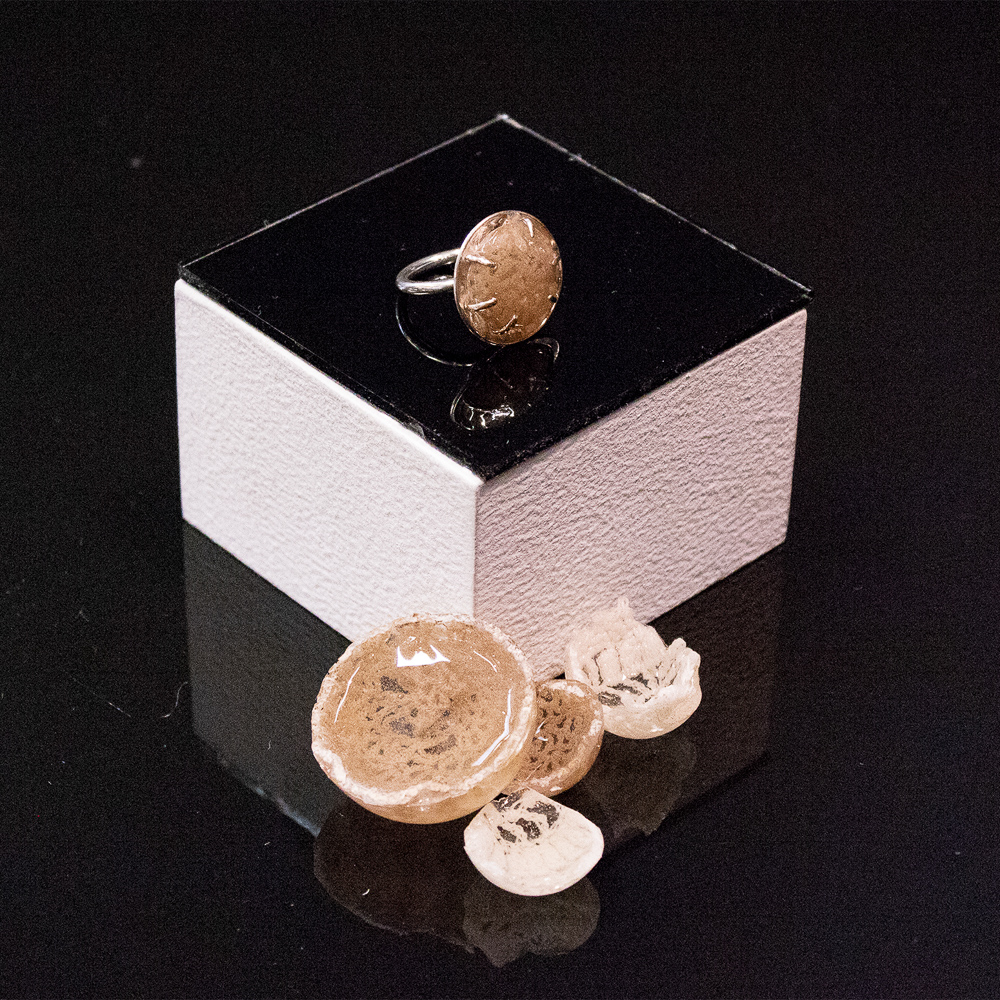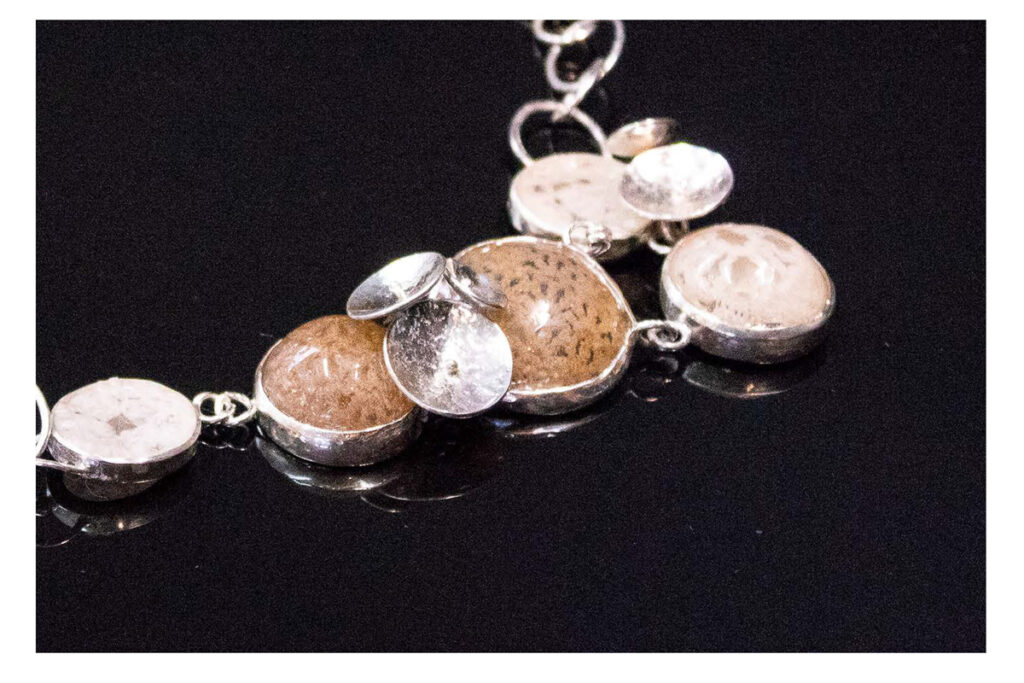
Michael McMillan (artist), Front Room Inna Joburg, 2016 Visual Identities in Art and Design (ViAD) research centre, University of Johannesburg,
Taryn Sadé Joseph is inspired by the “Coloured” aesthetic of her upbringing, reflecting an intense desire for respectability, ordentelikheid.
(A message to the reader in English.)
(A message to the reader in Afrikaans.)
Why? Why would you adorn each counter with a doily? Why so many doilies? Why so many lace tablecloths?
I’m interested to explore why certain objects, collections and configurations of home décor are common to “Coloured” homes and how they may be used in jewellery. In my jewellery, I am inspired by the dominant objects of décor pertaining to “Coloured” material culture as inspiration to create new pieces of jewellery. These include doilies, lace material and brass artefacts. They are nostalgic in nature, pertaining to my upbringing.
My interest began as I wondered why my folks decorated our home the way they did. Though my mother tried to steer away from anything that was considered typical to our culture, I found the use of certain signature items were still prevalent.
My mother had a set for every occasion. Like bedding, once a set was now dirty, there was surely another set to adorn her lounge coffee table, cabinets, side tables and more. The best was chosen to adorn the most seen places of our home. Many times they were put into rotation at different areas of our home. The lounge coffee table was not fully furnished without brass ashtrays on top of three separate doilies placed running the length of the table. Brassware served only one function: to decorate, deprived of their true function in apparent form. They had to be well maintained, polished that is. Shining bright, as if they were pure gold scattered around this small town home.
This was an unspoken trend, I was never told this is how it ought to be, but that was how it was. It was not a conversation piece. What was a conversation piece or lesson rather, was how everything should be clean, neat, and tidy. How it should appear that way.
The images below, from my personal collection depict my childhood home at Christmas time. This was a typical scene except for the additional Christmas decorations. Objects include lace table covers, dollies and a brass-shelving stand with various brass and copper ornaments. In the reflection of the mirror is a cabinet filled with various trinkets which my mother collected over the years and used as decorative elements. She collected these objects of various styles, from various times and across various mediums. She particularly liked arranging them according to their themes.
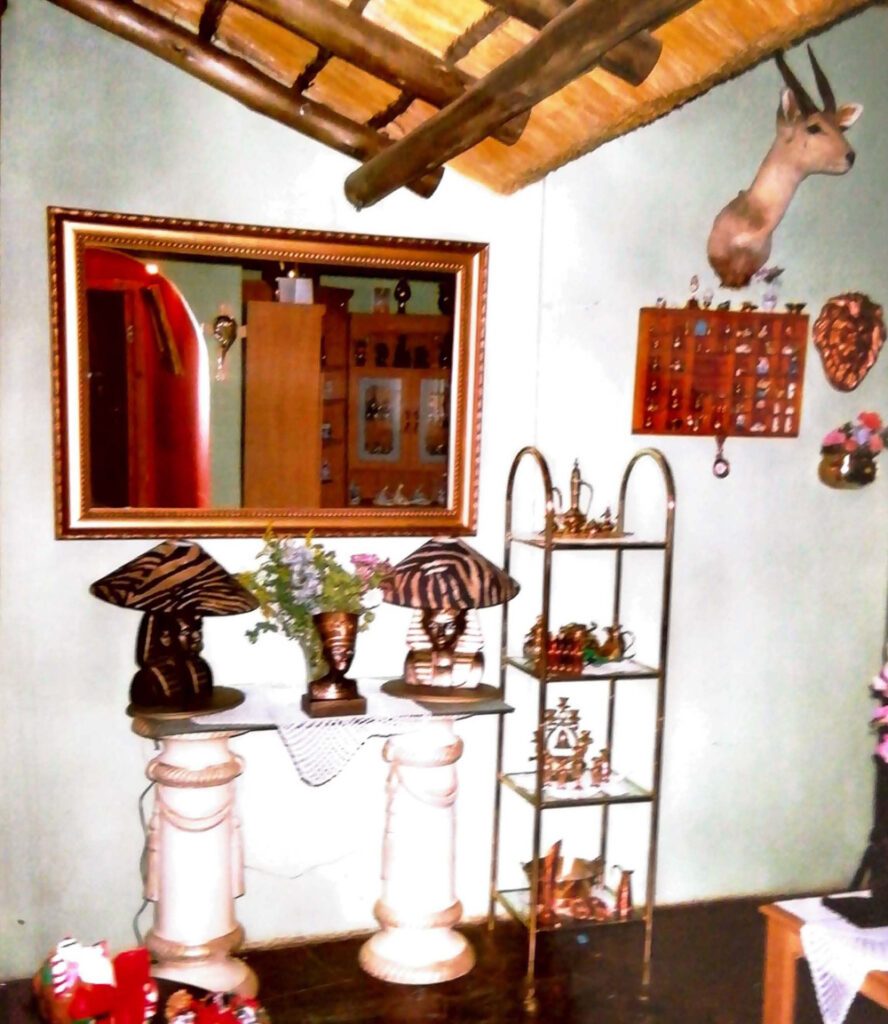
Taryn’s childhood home interior 1, Source: Taryn Sadé Joseph, Ennerdale Johannesburg, c2004
The living room cabinet contains a collection of porcelain ornaments of various shapes, sizes and forms. The cupboard also features brassware that is similar to objects featured in the preceding image. On top of the lace table-cover sits a glass vase, which contains a decorative arrangement of artificial flowers.
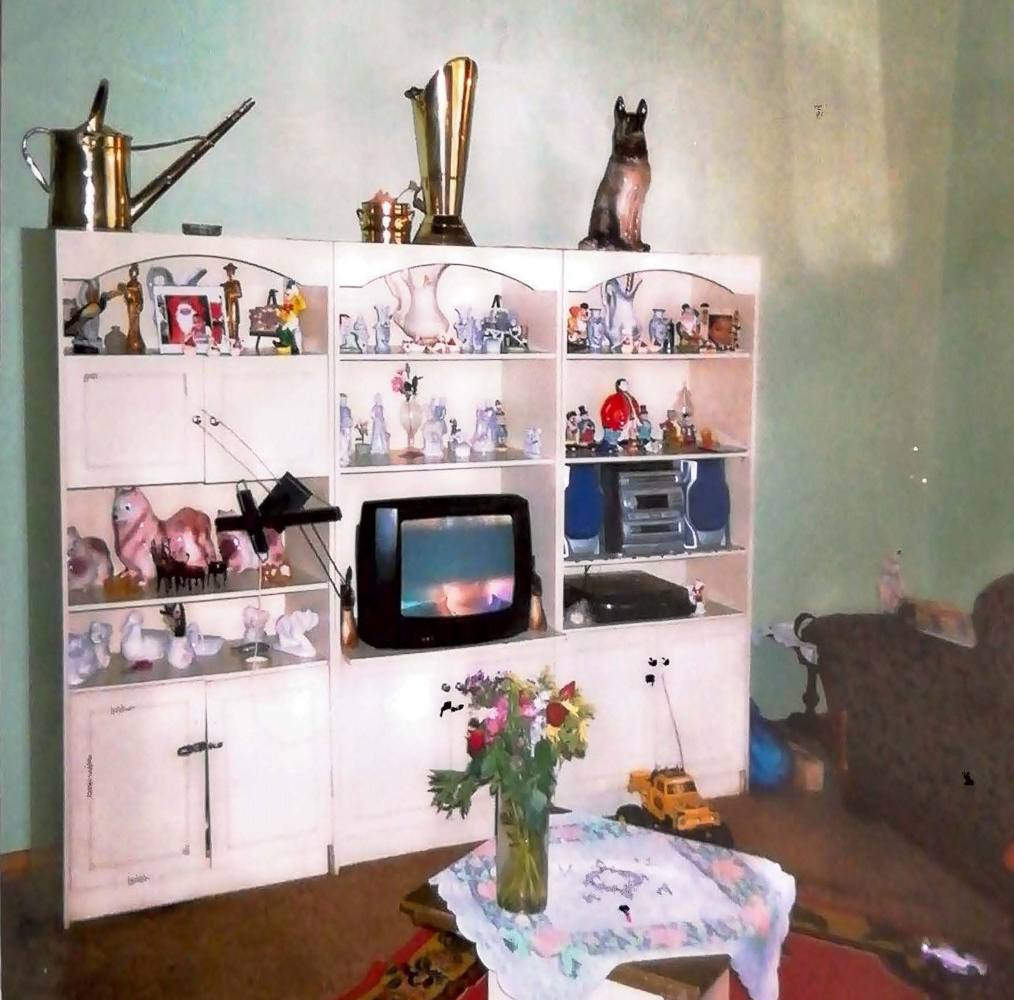
Taryn’s childhood home interior 2, Source: Taryn Sadé Joseph, Ennerdale Johannesburg, c2004
“Colouredness”
The term “Coloured” in a South African context was introduced in the Apartheid regime to describe a segment of the South African population who did not fit within the racial categories “black”, “white”, “Asian” or “Indian”, in order to maintain racial division under white supremacist laws. “Coloureds” are described as mixed-race individuals with multiracial ancestry that can be tracked to the contact between European settlers and the indigenous Khoisan on the South African west coast (Petrus & Isaacs-Martin 2012:92).
“Coloured” identity is a complex concept that is not easily defined due to the inherent ambiguity and fluidity of its people (Petrus & Isaacs-Martin 2012:89). This apparent confusion around “Coloured” identity stems from the imposed narratives on “Coloured” people during and post-Apartheid. I most agree with and adopt Petrus and Isaacs-Martin”s (2012:91) explanation that:
… far from being an imposition by one dominant group on another, Coloured identity is the result of the agency of Coloured people themselves who have blended elements from various South African and other cultures and fashioned them into a creative identity that, ironically, also possesses a uniqueness distinguishing it from the other cultures from which it has borrowed. Thus, Coloured identity is not simply a mish-mash of borrowed traits from other groups, but takes on a life and meaning(s) of its own.
This is not necessarily the only definition, or the most accurate one, but it situates my study and research effectively. To this end, it is evident that “Colouredness” is not an identity that is fictitious or baseless. It is for this reason why the term “Coloured” is used in my research despite its contentiousness.
It is generally perceived that “Coloured” people have no actual culture or identity and that they are simply a mixed race of individuals hailing from unscrupulous interracial unions (Petrus & Isaacs-Martin 2012:87). This view is derived from employing the essentialist approach to view the history/origin of “Coloured” people, which has proved quite problematic.
It is my belief that “Coloured” people’s material culture reflects the imposed narratives of the Apartheid era, and is still tainted by its legacy. This legacy and discourse is so pervasive that “Coloured” people have adopted it on both a conscious and subconscious level.
Interviews
My research explores “Coloured” identity, which I refer to as “Coloured identity” or simply “Colouredness”. Common aspects of material culture are identified in the living spaces of “Coloured” people of the Johannesburg South, Ennerdale area. I visited two homes to conduct interviews to identify objects of interest and commonality in each home. In addition, photographs of my childhood home were used as visual aids to identify objects of interest that I use as inspiration in the design and manufacture of my jewellery.
My aim is to design jewellery that has been inspired by “Coloured” culture; a range of jewellery that utilises artefacts of decoration commonly found in the homes of “Coloured” people.
Key inspiration is drawn from the work of Stephané Conradie a South African artist who makes use of found objects in “Coloured” homes to create striking pieces of art and Michael McMillan a “London-based writer, playwright, artist/curator and scholar of Vincentian migrant heritage” (McMillan 2018:2), more specifically his work on “The Front Room “Inna Joburg” installation.
McMillan’s photograph, Front Room Inna Joburg, depicts the tendency to over stylise the front room area. Many objects correlating to my childhood home and the interviewee’s homes are visible in McMillan’s installation. These add to the narrative of transcultural discourse, which underpins the material culture of what McMillan refers to as “Creolized” groups.
McMillan”s work is nostalgic of the interviewee”s homes, featuring much of the same objects of interest. These include artificial flower arrangements, porcelain figurines, glass cabinets, as well as crochet doilies and lace curtains. These objects derive from the Victorian bourgeois tropes adopted during colonial rule, “The ‘bric-a-brac’ practice of the Victorians to collect and to cram things together comes through the aesthetics of the front room…” (McMillan 2018:10). Symbolically, these objects speak to the appropriation of white culture and aspiration to these idealised tropes of respectability.
McMillan (2017:42) describes this as the aspiration not only in creolised culture but overall in black culture as well, “…that idealised Victorian bourgeois tropes.” These tropes manifest in the material culture of living rooms in order to not only gain respectability in culture but also serve as a marker of the freedom from slave narratives. In this case, material culture serves as a value system for those who ascribe, willingly or not, to a creolised culture. This serves as a key finding of the investigation.
Underlining themes were also discovered. Conradie, for example, states that these objects serve as markers that communicate a particular message to society, depicting their “Ordentelikheid [which] here comes to represent how residents choose to present an identity in living rooms and thus to the outside world.” (2017:3). “Ordentelikheid” here ties to the aforementioned term of “putting one’s best foot forward”, the notion of appearing to be respectable to the outside world. Ideals on civilized behaviour and people of colours’ aspirations to conform to the idealised protocols set by apartheid rulers. This goes further in my view, revealing aspirations to “humanness”, being portrayed as human through the constant aspirations to cleanliness, respectability and social status.
Artistic inspiration is drawn from art produced by Conradie and her research of the material culture of “Coloured” Cloetesville residents. Her work displays over stylisation, characteristic with front rooms in most “Coloured” homes and the front room installation by McMillan. Conradie makes use of found objects typical of the “Coloured “material culture and arranges them to recreate new pieces of art and decoration. Some of the objects in Conradie”s bricolage include broken ceramics, a ceramic ornamental cat, ceramic milk jugs, ceramic egg cup, silver cutlery, commemorative sugar spoons, and wall mounted brassware to name a few amongst the vast combination of objects.
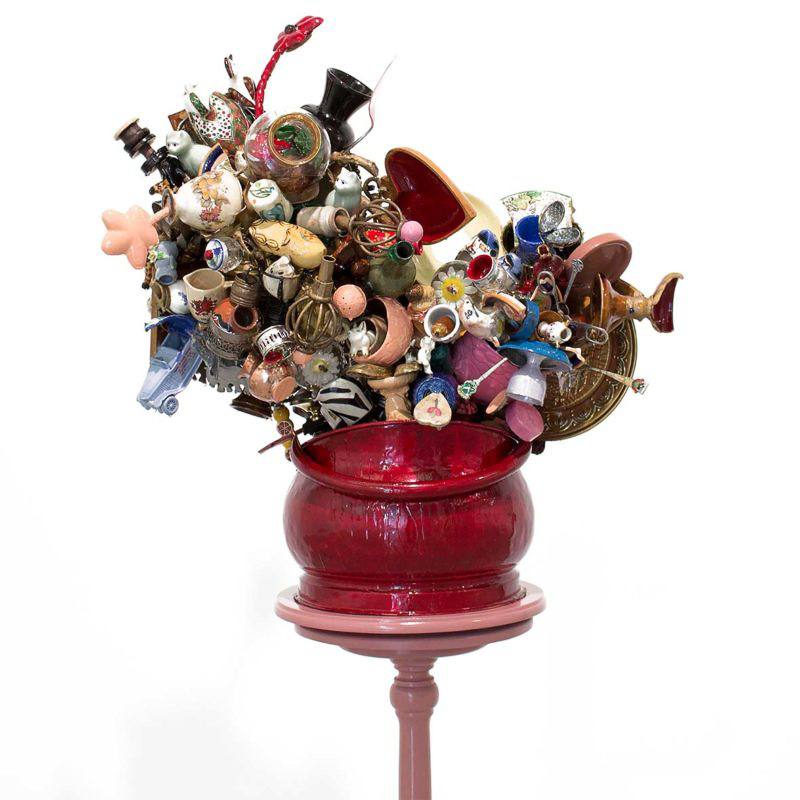
Stephané Conradie (designer), 2017, KWAAI (Eclectica Contemporary 2017). Source: Eclectica Contemporary, 2017. Eclectica Contemporary. [O] Available at: https://eclecticacontemporary.co.za/kwaai-group-exhibition/ [Accessed 18 July 2019].
My doily jewellery
The work I have produced uses elements of popular “Coloured” culture. I made use of doilies as inspiration and produced jewellery pieces using doilies, set in clear resin, these resin pieces were used as stones to form a necklace, ring and collar clip.
The spread lace structure of these doily pieces could also be considered to represent a visual representation of the rich interconnected web of diasporic or creolised histories, heritages and identities.
- Taryn Sadé Joseph (designer), A Coloured Account…, Necklace, third-year body of work, Collar clips and earrings, Sterling silver, crochet doily in clear resin; Source: Taryn Sadé Joseph, Johannesburg, 2018, (Photographer Mubanga Changa).
- Taryn Sadé Joseph (designer), A Coloured Account…, Necklace, third-year body of work, Sterling silver, crochet doily in clear resin; Source: Taryn Sadé Joseph, Johannesburg, 2018, (Photographer Mubanga Changa).
- Taryn Sadé Joseph (designer), A Coloured Account…, Necklace, third-year body of work, Sterling silver, crochet doily in clear resin; Source: Taryn Sadé Joseph, Johannesburg, 2018, (Photographer Mubanga Changa).
- Taryn Sadé Joseph (designer), A Coloured Account…, Necklace, third-year body of work, Sterling silver, crochet doily in clear resin; Source: Taryn Sadé Joseph, Johannesburg, 2018, (Photographer Mubanga Changa).
My research has shown that material culture is a key concern in “Coloured” identity. Certain everyday objects can give insight into “Colouredness”. These objects carry connotations and nuances of a past that may be conscious or subconscious, desirable or undesirable for those concerned. These legacy narratives are inherently woven into the meaning of these inanimate everyday objects.
Interestingly material culture as well as jewellery serve the same purpose and function: they adorn and represent the subject or space in a manner that conveys a deliberate idea/sense of value. Notions of material culture have the effect of presenting one’s self as complete, well put together and framed in a desirable manner. Similarly, jewellery serves to complete and finish off one’s appearance, to send messages of achieved style and to grant the adorned subject acceptance into an aspired social identity.
From the interviews conducted, it can be noted that though “Coloured” people view their means of decoration as simply ornamental, there are underlying meanings and symbols attached to many of the objects used. When asked why she used certain items such as brassware, and why they were of interest and importance to her, one of the interviewees responded, “It’s just for beauty, display, just for decoration…” (translation from Afrikaans by author), Responding to my question on whether these items made her home look more in order, or “Ordentelik” she responded “It is so, yes.” (translation from Afrikaans by author) in confirmation.
I do believe the meanings these objects hold are not fully perceived on a conscious level by “Coloured” people, but are steeped in ideas of appearing respectable and in order, being “well put together” and “putting one’s best foot forward”. “Ordentelikheid” that is an idea drawn and originating in the apartheid era in South Africa, because of Colonial rule.
The material culture of Ennerdale “Coloured” people can be used to create pieces of jewellery that are aesthetically appealing, seen in the work I have produced. These pieces draw on Victorian styles as well as the aspects of “Coloured” identity that were put up as show.
These pieces can be viewed as contemporary in nature as they demonstrate a highly artistic style and sophisticated aesthetic appearance. The pieces show the possibility for objects from “Coloured” homes to be used as a design inspiration for a range of jewellery.
In terms of artistic expression in general, Conradie’s work is one such example that shows how ornaments of everyday life are used to create new meaning. Conradie offers a fresh take on the items used in “Coloured” homes, to create as interesting and powerful pieces of design and that add to the ongoing and ever-changing “Coloured” narrative.
One of the main themes of the research is the aspiration “Coloured” culture has with the colonial narratives embedded in the unspoken narratives of this group of people. It is interesting to note that some writers believe this to be their plight to not assimilate, but to assist in the reconstruction of identity: the making and remaking of one’s identity and self.
Across the diaspora, objects of commonality and dominance can be noted and used as artistic inspiration, sharing discourse and opening up discussions about the increasing mixed narratives. Jewellery is one such medium and is able to open up conversations about material cultural themes of “Coloured” culture and identity.
In conclusion, research on material culture and “Coloured” identity has been done, and in addition to this, case studies of selected artists were performed. Stephané Conradie, who looks at “Coloured” material culture and interprets it in her desired art form and Michael McMillan, who works with creolisation in the diaspora. Primary research conducted on the front room décor of two homes in Ennerdale and the Author”s childhood home.
The intention of the research was to explore the reasons why certain objects, collections and configurations of home décor are common to these homes. The research indicates that, in line with international trends in Creolised cultures in the diaspora, such as; the mish-mash of various traits of each individuals culture into forming a new identity, the front room/”voorkamer” is the place in a home where aspirations, achievements, respectability and orderliness are conveyed to visitors – which in South African “Coloured” culture can be described as “Ordentelikheid”.
The jewellery designs that have emerged from my explorations draw on these themes, both to honour and critique them, and to provide another narrative around “Coloured identity” that disrupts negative stereotypes associated with “Coloured” people in South Africa. This work contributes not only to expanding the symbolic and political potential of jewellery design in South Africa, but also to the richness and diversity of “Coloured” culture.
References
Conradie, S. E. (2017). Coloured Cabinets: A reflection on material culture as a marker of Coloured identity in Cloetesville, South Africa. African Historical Review, 49(2), 1-21.
Eclectica Contemporary. (2017). Eclectica Contemporary. Retrieved July 18, 2019
McMillan, M. (2017). The Front Room Inna Joburg A Hybrid Intervention. Image & Text(29), 37-54.
McMillan, M. (2018). My Mother’s Best “Set”: Diasporic Threads of Crochet. Routledge, 1-19.
Petrus, T., & Isaacs-Martin, W. (2012). The Multiple Meanings of Coloured Identity in South Africa. Africa Insight, 42(1), 92.
VIAD. (2016). Retrieved September 10, 2019
Author
 I am Taryn Sadé Joseph a jewellery designer and manufacturer from Johannesburg South Africa. I come from a small town south of Johannesburg called Ennerdale. I am currently completing my final year in BTech Jewellery Design. My focus is on “Colouredness”, more specifically creating “Coloured” inspired pieces of jewellery speaking to the “Coloured” narrative, with hopes to tackle the negative connotations linked to this broad ever-changing group of people.
I am Taryn Sadé Joseph a jewellery designer and manufacturer from Johannesburg South Africa. I come from a small town south of Johannesburg called Ennerdale. I am currently completing my final year in BTech Jewellery Design. My focus is on “Colouredness”, more specifically creating “Coloured” inspired pieces of jewellery speaking to the “Coloured” narrative, with hopes to tackle the negative connotations linked to this broad ever-changing group of people.



